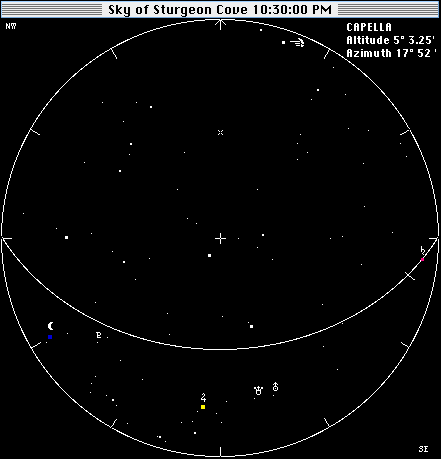On August 20, 1996, while aboard a sailboat at anchor in Sturgeon Cove,(in the North Channel of Lake Huron), in approximate position
46° 03´ North latitude
081° 55´ West longitude
I came up into the cockpit on a very dark and clear evening. The moon was just setting, and the skies were very clear, due to a strong westerly breeze that had been blowning all afternoon and evening.
I was using my 7x50 binnoculars to observe some stars and planets, Jupiter (I think) being very bright and its moons visible, although the slight motion on the boat at anchor made it difficult to hold the magnified images still.
I noticed, first by eye and then again with the binnoculars, an object quite low on the horizon, at an elevation of less than 20°, and at an azimuth of approximately 025° (True).
This object appeared to alternate from reddish to greenish and back, with a very short period of less than a second. The change of colors was quite distinct, and could be seen both by eye and with the binnoculars.
The time of this initial observation was approximately 10:30 EDT or 0230 UTC on August 21, 1996.
(From my vantage point at lake level, the terrain in that direction rises quite sharply to an elevation of 500 to 1,000 feet on the La Cloche Mountains of the Ontario shoreline, located some 4-5 miles away from my position. The object appeared in the sky above the crestline of the hills, so I am certain it was not a masthead navigation light of another sailboat close by.
The terrain also establishes the minimum elevation. I was five miles away from a 1,000 foot hill, so my minimum elevation visible over the hill was
Arcsin( 1000ft/(5 x 5280ft)), or about 2°.
I estimate the azumith of the object based on my location in the cove in which we were anchored and the object's appearance over the eastern shore of the opening in the cove. Thus the azimuth guess should be quite close.)
I then retired to the cabin and slept for an hour or so. I arose to check on the boat's anchor, and I again observed the object, this time having risen in the north-eastern sky an amount that seemed appropriate for the lapse of time since my last observation.
By this I decided that it must be a celestial object.
I am not an amateur astronomer, so when I returned home I solicited the help of the USENET community in identifying this object. I posted a message to sci.astro.amateur asking if anyone could recognize what star or planet I might have been observing. I also wondered if this change of color was a normal phenomena, or perhaps something caused by the long path (at low elevation) through the earth's atmosphere under unusual conditions. (I added that the weather had been extremely warm for that region for several days, and the air moving in from the west was noticeably cooler.)
I got a response from several USENET readers, most guessing that the object I had seen must have been CAPELLA, a bright star rising in that portion of the sky that evening. Dale Gombert wrote:
Almost definitely, you saw the star Capella, in the constellation Auriga
(the Charioteer)). Such twinkling is an effect of the earth's atmosphere, and is most noticeable in the brighter stars. Very pretty sight.Taking Dale's suggestion of Capella and my own information about time and place, I used the excellent Macintosh Astronomy calculator, MacAstro, to draw the appearance of the sky that evening in that location. Here is how MacAstro reconstructed the view that evening:

The results are in excellent agreement with my observations. My initial guess at altitude was "less than 20°," which turned out to be rather generous: the actual altitude of CAPELLA was closer to 5°. My estimate of azimuth was "approximately 25° (True) ," which was rather close to the actual azimuth of 17°, 52´ (almost 18°)!
Some additional information arrived via e-mail, suggesting that the red-green change was due to disturbances in the atmosphere. The day's weather—a sharp shift from warm to cold air—would create conditions likely to cause such a refraction.